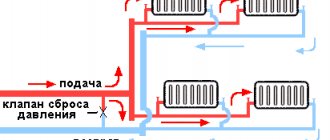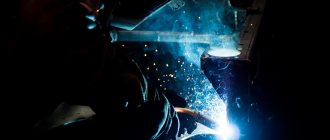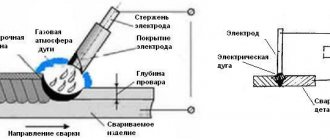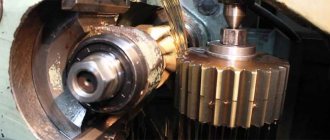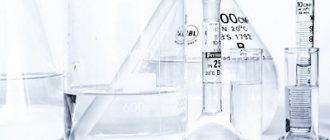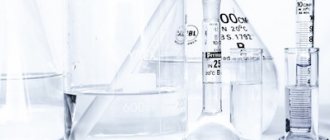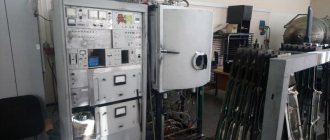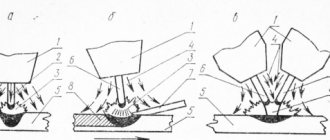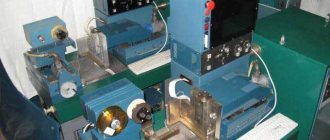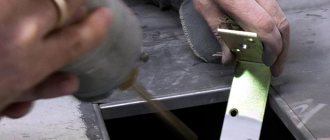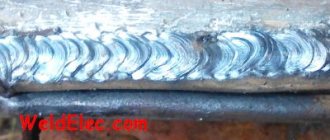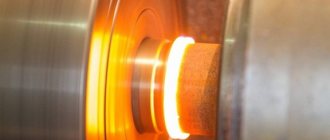The working surfaces of parts used to complete various types of equipment wear out over time. This leads to a reduction in the service life of the units. Laser surfacing is recognized as the most effective method for restoring the performance of parts affected by wear. A type of welding technology is also used to protect new mechanisms by hardening the surface of the product.
Modern version
Various enterprises use production plants equipped with metal parts, which wear out and suffer from corrosion under conditions of significant loads. To increase the wear resistance and strength of mechanisms, their surface is completely or partially covered with a layer of molten metal. The influx obtained in this way is firmly connected to the surface material, forming a single conglomerate.
To restore the functionality of an old part, a similar type of metal is fused, which allows the product to return its shape and integrity. If it is necessary to improve the quality of the top layer, it is coated with another material that gives the mechanism new properties.
Principle of technology
Laser surfacing (laser metal deposition technology) is one of the most effective methods for restoring coatings with increased wear resistance. The process involves modern laser systems equipped with powerful diodes and specialized nozzles. What's happening:
- Using a laser, a kind of melting bath is created on the surface of the selected area. The container is filled with metal powder entering through the nozzle opening.
- During laser processing, a short-term melting of the base material occurs. All stages are carried out with automatic regulation of the melting zone parameters.
The principle of laser cladding is the same as with electric arc and powder plasma additive bonded to the metal. The disadvantage of traditional types of surfacing is the submelting of the base under significant thermal influence on it. Processing of powder material with a locally directed beam of a powerful laser eliminates heating of the melting surface at a high deposition rate.
Advantages
- The ability to use different powders to create multilayer structures of your own alloys;
- ease of replacement of consumables, which is performed without stopping the work process;
- the ability to create three-dimensional structures on uneven surfaces with modified geometry;
- control of the degree of penetration with high-strength adhesion of the powder mixture to the top layer of the base;
- minimizing the influence of heat treatment on the local impact zone, eliminating the likelihood of deformation;
- high speed of creation of coarse and very fine structures, which is inaccessible to other types of melting;
- the ability to access any areas of large-sized products with rapid heating and cooling of the working area.
Laser surfacing of a metal surface is not without some disadvantages, the main one of which is the need to use complex and expensive equipment. Disadvantages of melting also include low productivity with low efficiency.
Advantages
Laser surfacing technology has a number of significant advantages:
- It is possible to change operating parameters. Allows you to adjust the physical and chemical properties of the deposited layer in a wide range.
- Providing minimal temperature impact on the part. It is ensured by high precision pulse dosage, short time and locality of its delivery. After work, the geometric shape of the workpiece is preserved.
- High adhesive properties. The source material and the deposited coating are connected very firmly. Not inferior to metallurgical processing.
- Increased hardness, viscosity, corrosion and thermal resistance of the deposited layer. The surface becomes resistant to wear, cracking, mechanical damage and other defects.
- Minimum allowances. Significantly simplifies finishing machining.
- It is possible to work with large-sized parts without dismantling them, processing internal and hard-to-reach surfaces. Provided by fiber technology for transmitting laser radiation.
- High accuracy of the thickness of the deposited layer and its physical and chemical parameters. The operator and software control the work process very precisely.
- Low cost of the process and efficiency of work in comparison with other methods of restoring damaged and worn metal surfaces. The technology does not require the creation and maintenance of high temperatures or long-term finishing. When working with chrome-plated products, there is no need to remove the protective layer.
All these advantages have significantly expanded the scope of application of laser cladding technology, making it popular in various industrial sectors.
Features of laser metal deposition
Due to the precise direction of the laser beam, during surfacing, a uniformly dense conglomerate of powder and base material is formed. The thickness of the metal liquefaction ranges from 0.2-1 mm; it is possible to create several such layers, located one above the other.
For drawing lines, edges or contours, the installation is equipped with an optical device with the ability to automatically move. The uniform distribution of layers is ensured by an intelligent sensor system. Progressive surfacing technology is implemented using two types of laser radiation – pulsed and continuous.
Pulse laser surfacing
Melting using this method is performed by simultaneous delivery of the laser beam and the filler element to the intended area of direct deposition. When melted, the additive material (wire, powder) spreads evenly over the damage site.
After treatment with a pulsed laser, the defect area will not have to undergo long-term mechanical correction. To prevent metal oxidation, the melt bath is protected by supplying a mixture of inert gases (argon and helium).
Laser deposition is carried out using one of two methods presented in the table below.
| Pulse surfacing type | Characteristic |
| Manual technique | For work performed manually by the operator, the additive is wire with a diameter in the range of 0.15-0.8 mm. This can be a material identical to the base or with increased hardness. The work is carried out under the control of a microscope with 10-16x magnification; the diameter of the laser beam (0.2-2.5 mm) should be 2 times the diameter of the additive in order to reduce the volume of heating and melt. The method of manual metal deposition is used to eliminate small chips, pores and other local surface defects. The configuration of machines with lasers allows you to process small parts and repair large mechanisms |
| Automated | Robotic technology is more often used to protect new parts from signs of wear. The reason is the low probability of crack formation in the deposited layer. During the creation of laser surfacing, the supply of the additive is mechanized. If a metal powder is selected, its delivery to the melting point is ensured by a nozzle. Automatic surfacing is used when it is necessary to deposit significant volumes of metal |
The advantage of a pulsed laser is the minimal size of the area of influence at a high speed of the process. These factors reduce the heating of the part and prevent the spreading of metal around the laser guidance zone, which is important for performing different volumes of surfacing work.
Continuous laser cladding
This type of surfacing technology provides high productivity with minimal heat input of the laser beam compared to other types of melting and welding. Continuous laser processing is used for materials that are difficult to weld. The average value in the mixing zone of the base metals and filler material is in the range of 10-30 microns, taking into account the deposition modes and varying the deposition thickness in the range of 0.3-3 mm during one pass.
The design of production systems for performing internal surfacing manipulations is fundamentally different from installations for metal deposition on the external surfaces of mechanisms. Laser machines for interior work are equipped with prisms or mirrors designed to reverse the light streams.
Undoubtedly, laser methods of surfacing materials have a promising future for mechanical engineering production. However, to achieve a technical and economic effect, it is useful to know the capabilities and limitations of these methods, as well as the areas in which their use has no alternative.
Laser surfacing has been known since the 80s of the 20th century. During this time, not only technologies and devices for applying this method have improved, but also a number of alternative technologies have appeared that are in some competition with each other. The purpose of this article is to summarize the development of laser surfacing from the point of view of technical and economic efficiency and to outline the prospects for its further implementation in mechanical engineering. The main advantages of laser surfacing are: • minimal warping and distortion (an order of magnitude less than with other types of surfacing) due to the reduced thermal effect on the base; • the possibility of forming a weld pool of the melt from above, which ensures obtaining the chemical composition of the deposited material with minimal penetration of the base; • the possibility of forming a surfacing composition in a thin surface layer; • the ability to fuse hard-to-reach parts of parts; • the possibility of obtaining metal-ceramic surface layers with a given set of properties. What types of laser cladding are known? A classification can be given according to the filler materials used: • laser surfacing of wire; • slip surfacing - from slip layer paste; • laser surfacing from powder strip; • gas-powder surfacing - from supplied powder in a stream of protective gas; • melting the powder in bulk using a dispenser; • penetration of gas-thermal coatings applied by spraying methods. What are the main directions of implementation of laser cladding today? First of all, the active introduction of laser cladding continues on parts that require a deposited layer of less than 1 mm. It is almost impossible to obtain such a layer by other methods. An alternative to this method is spraying and, in some cases where there are no bending stresses, it is actively used in industry. The meaning of laser surfacing manifests itself on those parts for which the adhesion of sprayed coatings is small compared to the effective stresses, and, of course, in the presence of bending stresses. In addition, the porosity of the coating often plays a cruel joke on sprayed parts. When exposed to the environment, rapid corrosive destruction occurs. One could dismiss this number of details, but, as they say, “the spool is small but expensive.” A special place is occupied by laser penetration of coatings; such technologies occupy an intermediate position in terms of the properties of surface layers between sputtering technologies and laser cladding. The fact is that the adhesion of such fused coatings is many times higher than the adhesion of the coatings themselves, and this type of processing is quite common, although it is incorrect to talk about surfacing in this case - the coating itself is welded to the base. But the quality of welding depends on the development of technology and is a difficult technological task. Another direction is laser surfacing of hard-to-reach parts of parts, for example, valve seats and other valve parts; this is a promising direction. In addition to the technical result, savings are achieved in reducing the volume of surfacing, filler materials and reducing the cost of machining parts. The economic effect of manufacturing one part can exceed 3,000 rubles. The next direction is the use of gas-powder laser cladding. The formation of the weld bead occurs from above. With a certain selection of processing modes, it is possible to obtain beads of a given shape and the chemical composition of the deposited filler material with a low degree of penetration of the base ( Fig. 1 ). But in this case, the productivity of laser surfacing will approach the productivity of plasma surfacing, and the cost indicators will not be in favor of the laser method. Alas, plasma is cheaper. But in those rare cases when leashes are unacceptable and it is necessary to exclude the influence of inevitable heating, the laser has undeniable advantages. The leashes with the laser method can be significantly (by orders of magnitude) reduced.
Rice. 1. Microstructure of the deposited bead during gas-powder laser surfacing on bronze BRAZHNMts 9-4-4-1
A particularly relevant area is additive computerized methods of layer-by-layer deposition based on gas-powder laser surfacing (for example, on the surface of blades) with obtaining the necessary properties and chemical composition and shape of the deposited bead. Such laser installations appeared in Moscow and St. Petersburg and other large centers. But the cost of manufactured parts is high, and productivity is low. The method is used for the manufacture of products from non-ferrous expensive alloys, titanium and composite parts. Typically, installations are sold for a specific production and are very expensive. A cheaper alternative to the prototyping method is laser cladding, which produces a specified set of material properties in the surface layer. This method is based on the difference between laser radiation and other heating sources. The fact is that light energy heats the surface of non-metallic materials faster than metal ones. For example, a ceramic particle has a fused surface after just a few microseconds of irradiation. By varying the fraction of the filler material and suppressing the negative aspects of the decomposition of non-metallic particles, it is possible to achieve the formation of specified structures in the surface layer and even to deposit metal-ceramic materials with a high proportion of the ceramic phase. It is possible to obtain properties in the surface layer of materials that cannot be obtained in the weld bead using conventional surfacing methods. What problems can be solved with this technology? Let us present some results obtained by the author. From Fig. Figure 2 shows that the structure of the metal-ceramic material deposited using this technology consists of primary and secondary ceramic particles obtained by interaction with laser radiation. The particles are well wetted. There are no defects. The deposited metal-ceramic layer with a ceramic phase fraction of more than 65% has heat resistance up to 1100°C, corrosion resistance, and abrasive resistance 3 times higher than steel subject to improvement.
Rice. 2. Electron microscopy of the deposited metal-ceramic surface layer
Rice. 3. Change in the chemical composition along the cross-section of the processing zone at the metal-ceramic phase boundary
Let us consider the change in the chemical composition of such a roller ( Fig. 3 ). The figure shows the presence of a fairly deep transition zone in the particle and in the body of the matrix, which indicates the decomposition of the particle and the enrichment of the melt bath with elements of the ceramic particle. A similar distribution of chemical elements with significant assimilation of the decomposition products of the ceramic particle occurs in another case ( Fig. 5 ). Comparative wear characteristics of deposited metal-ceramic materials are presented in Fig. 4 . It can be seen that the creation of layers with a given structure makes it possible to obtain wear-resistant materials on the surface of materials that are difficult to harden. In fact, any material can become wear-resistant thanks to such surfacing.
Rice. 4. Wear of the materials under study with laser cladding of the surface and without hardening
Rice. 5. Distribution of elements near the fusion boundary of ceramics and metal
The distribution of chemical elements at the ceramic particle-matrix interface is shown in Fig. 5 . Data in Fig. 5 confirm the production of materials with high friction properties. Frictional properties with continuously adjustable friction coefficient can be easily obtained on the surface of a wide range of materials. With the correct use of technology and filler materials, it is possible to obtain cheap types of surfacing for solving various mechanical engineering problems. The mechanical properties of metal-ceramic layers are given in table. 1 . Using this technology, it is possible to obtain unique self-lubricating layers for mechanical engineering parts based on graphite and molybdenum disulfide ( Fig. 7 ). The antifriction properties of this material are close to those of molybdenum disulfide coatings. Industrial tests of adapters with metal-ceramic surfacing, performed using a laser beam, showed that their service life increased by 4–5 times. Tests were carried out while drilling rocks at the Kaula-Kotselvaara mine [1].
Figure 6. Change in the friction coefficient depending on the aluminum oxide content for the Br-Graphite-Al2O3 composition
Rice.
7. Microstructure of self-lubricating surfacing material based on molybdenum disulfide Table 1. Mechanical properties of deposited metal-ceramic layers
| Options | Yield strength, MPa | Tensile strength, MPa | Residual stresses, MPa |
| Cr3C2-Ni80Cr20 | 1200+50 | 1570+50 | –480+50 |
| MoS2-Mo-Cr | 750+50 | 1180+50 | +325+50 |
Another example of the use of metal-ceramic surfacing. Parts of winch mechanisms are subject to intense wear, which leads to frequent failure of the crackers, which is why ships need to have a significant supply of these parts. The load on the rubbing pair is 6–8 MPa. Parts operate in sea fog environments with limited lubrication. At the stand, crackers made of BrOF10-2 bronze with untreated and metal-ceramic surface layers paired with a screw made of steel grade 14Х17Н2 were subjected to comparative tests. It was found that with a test duration of 22 hours, the wear of unstrengthened bronze was 100 microns, and the metal-ceramic layer showed no visible wear after 35 hours. And in only 114 hours the wear of the latter amounted to 100 microns. Thus, the performance of crackers with a metal-ceramic layer increased by 4.5 times. Based on this technology, it is also possible to introduce some superhard materials. With its help, you can solve any problems of wear resistance, abrasion resistance, heat resistance, friction and antifriction problems, while using cheap materials. According to the authors, such laser surfacing will undoubtedly be widely used in mechanical engineering. Since we are now in a situation where the introduction of such technologies is just beginning, it is important to know the capabilities of various laser cladding methods, and its effectiveness is confirmed by practice and extensive material science and technological work. V. O. Popov, “Laserterm” V. A. Krasavchikov, S. N. Smirnov JV “Lazertech” Literature 1. Skripchenko A. I., Popov V. O., Kondratyev S. Yu. Possibilities of laser surface modification of mechanical engineering parts // RHYTHM. - 2010. - No. 6. - P. 23–29.
Types of coating work
Laser surfacing technology is implemented by applying a layer of metal to the surface of a worn mechanism, as a result of which the additive is welded to the base. Taking into account the minimal melting of the base, it can be argued that the properties of the surfacing depend on the material used as an additive. In modern production, the supply of costly material is carried out in one of three main ways.
Laser beam melting
The surface of the part is pre-coated with powder paste, selecting a coating composition that meets certain requirements. Melting with a laser beam is carried out sequentially to cover the entire intended area. If you need to create a multilayer coating, after each laser scan, apply the next layer of paste, for each layer a separate layer of coating.
Advantages: surfacing, which is simple in technology, does not burden the structure of the unit. The disadvantages include the labor-intensive deposition process, the unevenness of the deposited surface due to the tension of the surface film of the molten metal.
Lateral supply of gas-powder mix
Until recently, laser cladding of this type was used most often. The powder is supplied into the melting bath by injection from the side of the laser beam or towards it. During deposition, beads with different types of geometry are formed.
Advantages - thanks to gas-powder technology, a higher-quality cladding layer is created. The influx is characterized by uniform thickness and chemical composition, opening up the possibility of using composite materials while maintaining the hardening phase. The disadvantage of the technique is due to the asymmetrical delivery of the powder relative to the line of motion of the laser beam. Even when scanning it in a flat projection.
Coaxial fusing method
The gas-enriched powder is supplied through a nozzle directly into the laser operating area in a continuous cone-shaped flow. The technique is recognized as the most universal way to form coatings of a homogeneous or composite type for flat and three-dimensional parts.
Advantages - guaranteeing symmetry with respect to the direction of melting, uniform adhesion of the welding beads. Laser surfacing is characterized by high productivity using additives for difficult-to-process surfaces. A characteristic feature, as well as a disadvantage of creating an overlay, is the difficulty of ensuring a feed with uniform symmetry.
The main quality parameter of laser deposition is directly related to powder consumption. To regulate the thickness of the deposited metal layer, its liquefaction and hardness, it is necessary to select the appropriate diameter of the beam flow in combination with the power of the installation, as well as the speed of the process.
Scope of application of laser surfacing
By fusing using laser welding, it is possible to eliminate damage caused by chips, crushing, wear, and fracture:
- edges of casting molds, including those used for working with rubber and plastic;
- bearings on shafts, gears, teeth in splined fastenings;
- elements of hydraulic systems: valves of suction and discharge lines, spools in hydraulic distributors;
- in the end part, in the area of the base and rib of the airfoil of gas turbine engines;
- turbine compressor rotors;
- products of their alloys of increased strength, operating under conditions of shock and shock-abrasive loads: hydraulic drills, vibratory hammers, cutting dies, etc.;
- large-sized metal products weighing tens of tons.
These are not all cases where laser cladding technology will be the optimal solution for restoring metal products. It will find worthy use in both small workshops and large enterprises.
offers specialized systems for laser cladding with reliable guarantees and delivery throughout Russia. If necessary, consultants will come to the rescue and help you select equipment for the specific features of the upcoming work. To contact them, use the feedback form or call us.
Where is it used?
The liquid metal deposition technique is widely used by modern industry to restore areas of parts that have suffered damage. Laser surfacing is used not only for repairing and strengthening coatings, but also for creating sets of new parts.
- EHLA. The technology is designed for high-speed creation of coatings with reduced thermal costs.
- SLM. High-precision technique for selective sintering of powders to define layer-by-layer flow contours.
- LMD. A method of directly growing parts by coaxial deposition, precision requires special resources.
In metallurgy, shipbuilding and the oil and gas industry, laser surfacing is most often chosen to strengthen individual sections of workpieces or correct their geometric parameters. The ability to experiment with metal deposition options opens up prospects for creating parts of various shapes. Laser surfacing allows you to quickly restore the functionality of expensive mechanisms, saving money and time.
Literature and sources used:
- Wikipedia article
- Handbook on magnetic pulse processing of metals. / B. N. Badyanov. - Ulyanovsk: Ulyanovsk State Technical University Publishing House, 2000.
- Sosnin N. A., Ermakov S. A., Topolyansky P. A. Plasma technologies. A guide for engineers.. - St. Petersburg: Polytechnic University Publishing House, 2013.
Cladding
Clad materials are two-layer or multi-layer metal-metal combinations produced by various cladding methods. Clad layers of metal are usually much thicker than layers obtained by other surface treatment methods.
The industry produces clad sheets, strips, pipes and sectional profiles. Cladding provides such a combination of properties of individual layers that the efficiency of using clad materials is higher than each of the components of their components.
Various combinations of metals and alloys are used for cladding:
- aluminum and carbon steel;
- aluminum and corrosion-resistant steel,
- aluminum and titanium;
- bronze and steel;
- chromium-nickel steel and carbon steel;
- molybdenum and corrosion-resistant steel;
- brass and carbon steel;
- niobium and carbon steel;
- nickel and copper;
- titanium and carbon steel, etc.
Depending on the purpose, the following indicators of clad materials are required: strength, ductility, corrosion resistance, wear resistance, thermal conductivity, etc.
Clad materials are not only substitutes for homogeneous (solid expensive materials). In many cases, due to the combination of properties of their components, they have more favorable performance than homogeneous expensive materials on their own.
Most methods for producing clad materials come down to two working stages: obtaining the initial bimetallic product (blank) and pressure treatment of the bimetallic workpiece to obtain the finished clad bimetal. Exceptions include rolling of strip or powder onto strip and, to some extent, explosion cladding.
Among the methods for producing clad metals, the following are common:
- combined casting, when perforated separating sheets are placed in the ingot mold, marking the position of the future connection plane between different steels, then they are poured simultaneously from two ladles through two funnels, controlling the equality of the heights of the liquid metal mirror in both parts of the mold. The bimetallic ingot is then rolled into clad sheets or shaped profiles;
- a combination of solid and liquid metal, in which solid metal plates of an alloy of a certain chemical composition are placed in a suitable mold and secured, and then liquid metal is poured around it. Bonding (setting of layers) is usually achieved only during rolling of the bimetallic ingot;
- a batch rolling method in which clad sheets are produced by rolling assembled and welded multilayer stacks. Depending on the purpose, the location and number of layers may be different (two-, three- and four-layer bags). Sheets can be single- or double-sided cladding. This method is most widespread. Its essence lies in the fact that the base and cladding metal are collected together into a package, which is welded with sealed seams. Then, before rolling, the package is heated to temperatures at which the dissolution and reduction of oxides occurs on all surfaces of the sealed volume. Subsequent rolling with a reduction value of at least 60% leads to welding of the base metal with the cladding layer;
- the cold rolling method is used to produce two- or three-layer clad strips by cold rolling, for example Al + Fe + Al or Cu + Fe + Cu (Fig. 1, a);
- Explosion cladding (Fig. 1, b) is used mainly for such pairs of materials that are difficult to connect using other cladding methods or for the manufacture of special-purpose products. In this case, connection (seizure) is also possible between metals that do not dissolve one in one, form intermetallic compounds at elevated temperatures, or differ sharply in resistance to deformation.
Rice. 1. Methods of metal cladding : a – cold rolling; b – explosion cladding
This method is characterized by the use of the base metal and cladding material (coating) in a cold state.
The essence of explosion cladding is that an explosive with a detonator is placed on the surface of the cladding sheet. As a rule, the cladding sheet is placed at an angle to the base. During an explosion, during the collision of the plates, a jet of metal emerges from the surface layers of the base and cladding material. Along with it, contamination is also removed, which contributes to the formation of clean surfaces when joining materials. Deformation processes during impact occur at pressures up to 15 MPa, corresponding to the movement of shock wave fronts.
Cladding is also done by rolling powder onto a strip and by rolling a powder strip.
The listed cladding methods provide for the production of cladding layers from several to 20 mm.
